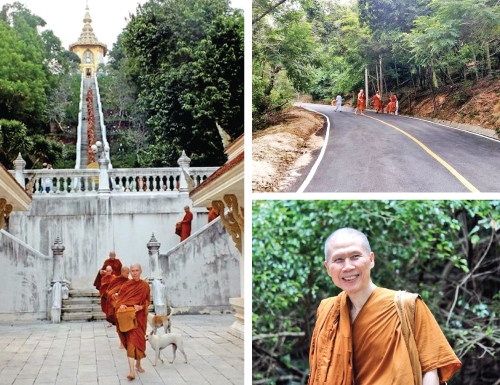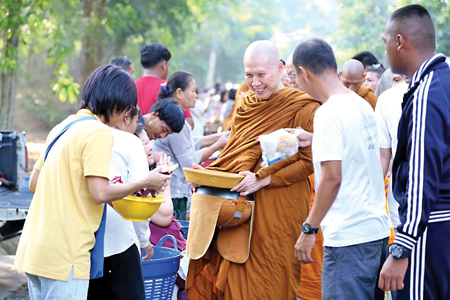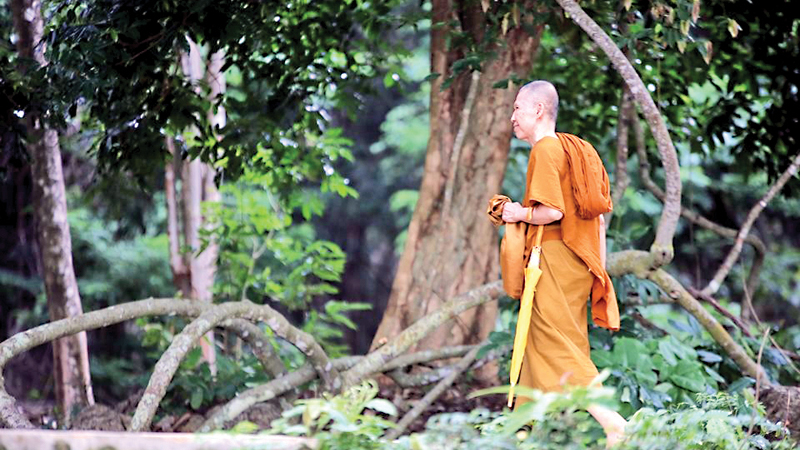Following are excerpts from an interview with Ven. Ajahn Suchart Abhijato Maha Thera of Thailand. The Maha Thera is well known across the globe for his impactful Dhamma teaching methods and meditation practices.
Q: As you mentioned earlier, once mindfulness is well developed, we can fully practise Anapanasati meditation. As we delve into this deep meditation, what should we do if we start seeing a ‘ light’ ( a bright light)? Should we carry on with our meditation?
 A: Yes. Just disregard everything that appears during meditation. Keep focusing on your breath until eventually the mind becomes still and everything becomes empty. Before that, you have to keep watching your breath. Don’t go away from the breath, no matter what happens. Don’t be distracted because once you are distracted you stop right there and you will not move forward in your meditation practice.
A: Yes. Just disregard everything that appears during meditation. Keep focusing on your breath until eventually the mind becomes still and everything becomes empty. Before that, you have to keep watching your breath. Don’t go away from the breath, no matter what happens. Don’t be distracted because once you are distracted you stop right there and you will not move forward in your meditation practice.
Q: Could you provide some guidance or recommend a mediators’ guide ( a book or e-resource if available) for people who are keen to further develop their meditation practice, but are unable to get in touch with a qualified meditation teacher due to many practical reasons?
A: Well, meditation is simple, but doing it is difficult! It is hard. You can summarise meditation in just one sentence; be mindful of your meditation object. That’s all.
Use a meditation object and stay mindful of that meditation object. Don’t go away from it. Then don’t let your mind go and think about other things. Then this meditation object will lead you to peace and calm eventually.
Q: If one wants to develop Vidarshana meditation, what fundamental steps should he/she take? Is it appropriate to commence the practice (practising Vidarshana) with Anapanasati meditation?”
A: Yes, you need to practise mindfulness meditation first to get to Jhana.Once you get to Jhana then you will be able to study the nature of the body first, then the nature of the feeling and then the nature of the mind as being Anicca Dukkha and Anatta and let go of your attachment towards them.
Q: What exactly is Anatta?
A: Anatta means ‘no self.’ There is no self in anything. It is our delusion to think that there is a self. A self is just a creation of the mind. The delusion of the mind creates this concept of a self when in fact everything is a natural phenomenon.
Q: If there is no ‘Self’ or ‘I’, who are we? For example, if a person passes an exam, is it not the same person who passes the exam? If so, who actually passes the exam?
A: It is the mind – the one who knows, the one who thinks, is the one who studied the texts and then passed the exam!
Q: What basic steps should be followed to attain Sotapanna while still leading a lay life? Could you explain in simple terms?
 A: Well, firstly you should give to charity – you should give away what you don’t need. Do not hang on to what you do not need. Keep only what you need – only the basic necessities of life.
A: Well, firstly you should give to charity – you should give away what you don’t need. Do not hang on to what you do not need. Keep only what you need – only the basic necessities of life.
Secondly, you should keep the Eight Precepts.
Third, practise mindfulness to get into Jhanas. Then study the nature of the body as being Anicca, Dukkha, and anatta.
Q: Since the Fourth Precept simply prohibits telling lies, some Buddhists are of the view that idle chatter, using abusive language, and carrying tales are not sinful activities. What constitutes Right Speech in Buddhism? Could you please elaborate on this?
A: It depends on how much you want to follow this. Say if you want to keep the Five Precepts or the Eight Precepts, you only need to abstain from false speech or rather not to lie. But if you want to be more refined, and more respectable in the eyes of other people, then you want to say things that will not offend people, so you want to abstain from all four types if it is possible. For monks – we are required to keep all four. We are not supposed to use false language, idle chatter, hateful speech, or divisive speech. We should avoid all these kinds of speech.
-– Ven. Ajahn Suchart Abhijato Maha Thera was born on November 2, 1947. Having completed his degree in Civil Engineering at California State University, Fresno, USA, he returned to his motherland where he designed an ice cream parlour for a brief stint.
Quite soon, inspired by a Dhamma book, he decided to go in search of “true happiness,” to find inner peace through the practice of Buddhist meditation. He became a bhikkhu at the age of 27 and received ordination at Wat Bovornives in Bangkok on February 19, 1975, with Somdet Phra Ñanasarivara, the late Supreme Patriarch (Somdet Phra Sangharaja), as his preceptor.
Ven. Ajahn Suchart Abhijato Maha Thera resides in Wat Yansangwararam, Thailand.









